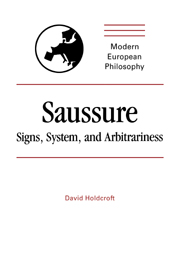Book contents
- Frontmatter
- Contents
- Preface
- Introduction
- 1 Saussure's work: its context and significance
- 2 The distinction between langue and parole
- 3 Language as a system of signs, I: Signs, arbitrariness, linearity, and change
- 4 Language as a system of signs, II: Diachronic and synchronic linguistics
- 5 Language as a system of signs, III: Identities, system, and relations
- 6 Language as a system of signs, IV: Values, differences, and reality
- 7 Successes and failures
- Notes
- Bibliography
- Index
- Frontmatter
- Contents
- Preface
- Introduction
- 1 Saussure's work: its context and significance
- 2 The distinction between langue and parole
- 3 Language as a system of signs, I: Signs, arbitrariness, linearity, and change
- 4 Language as a system of signs, II: Diachronic and synchronic linguistics
- 5 Language as a system of signs, III: Identities, system, and relations
- 6 Language as a system of signs, IV: Values, differences, and reality
- 7 Successes and failures
- Notes
- Bibliography
- Index
Summary
The Course in General Linguistics is not an easy book to read. Apart from the fact that for much of the time Saussure was preoccupied with fundamental issues about the nature of language and the methodology of linguistics, the text itself is not Saussure's but one reconstructed by Charles Bally and Albert Sechehaye from students' notes of the three lecture courses in general linguistics that he gave. The difficulties of reconstruction they faced were formidable (1.3); and though their achievement was an extraordinary one, the structure of the resulting text does not make it easy to follow Saussure's argument. This apart, he himself clearly did not think his theory as it stood was ready for publication. If at times his argument seems incomplete or inconclusive to the reader, so too it did to its author, though one can, for the most part, only guess in what respects it seemed deficient to him. Furthermore, the text has been a victim of its own success. Saussure's claim that the primary linguistic study is the study of a state of a language as it is constituted at a particular time (a so-called synchronic study) rather than one of its evolution through time (a ‘diachronic’ study) has come to be so widely accepted that it is hard to see how anyone could have thought otherwise. Yet much of CLG has to be seen as a critique of nineteenth-century historical and comparative linguistics, which did indeed assume that one can engage in historical and comparative studies without grounding them in synchronic ones (1.1).
- Type
- Chapter
- Information
- SaussureSigns, System and Arbitrariness, pp. 1 - 3Publisher: Cambridge University PressPrint publication year: 1991



